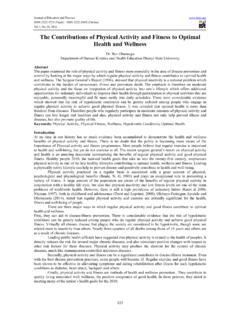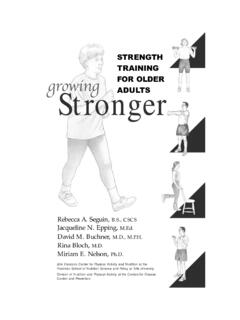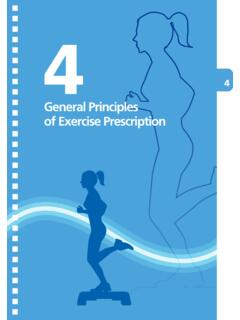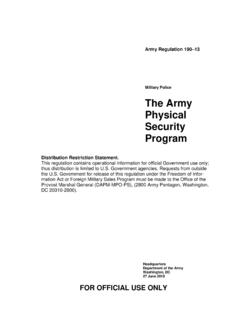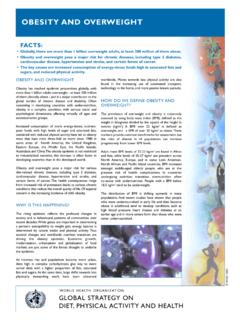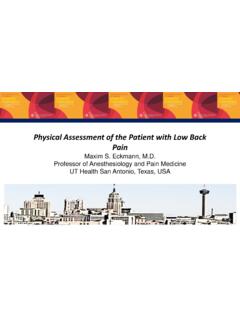Transcription of The CDC Guide to Strategies to Increase Physical Activity ...
1 Strategies to Prevent Obesity and Other Chronic DiseasesThe CDC Guide to Strategies to Increase Physical Activity in the CommunityNational Center for Chronic Disease Prevention and Health Promotion Division of Nutrition, Physical Activity , and ObesityFor Free Copies CDC Guide to Strategies to Increase Physical Activity in the CommunityCenters for Disease Control and Prevention1600 Clifton , GA 30333 Call1-800-CDC-INFO (1-800-232-4636) TTY: 1-888-232-6348 Suggested CitationCenters for Disease Control and Prevention. Strategies to Prevent Obesity and Other Chronic Diseases: The CDC Guide to Strategies to Increase Physical Activity in the Community. Atlanta: Department of Health and Human Services; site addresses of nonfederal organizations are provided solely as a service to readers.
2 Provision of an address does not constitute an endorsement of this organization by CDC or the federal government, and none should be inferred. CDC is not responsible for the content of other organizations Web to Prevent Obesity and Other Chronic DiseasesThe CDC Guide to Strategies to Increase Physical Activity in the Department of Health and Human ServicesCenters for Disease Control and PreventionNational Center for Chronic Disease Prevention and Health PromotionDivision of Nutrition, Physical Activity , and ObesityiiiiiiiiiiContentsIntroduction to Physical Activity ..3 Strategy 1. Community-wide campaigns ..5 Strategy 2. Point-of-decision prompts to encourage use of stairs.
3 9 Strategy 3. Individually adapted health behavior change programs ..13 Strategy 4. Enhanced school-based Physical education ..17 Strategy 5. Social support interventions in community settings ..21 Strategy 6. Creation of or enhanced access to places for Physical Activity combined with informational outreach activities ..25 Strategy 7. Street-scale urban design and land-use policies ..29 Strategy 8. Community-scale urban design and land-use 9. Active transport to school ..37 Strategy 10. Transportation and travel policies and practices ..41 References ..45 Using This Guide ..1iiiv1iv1 Using This GuideThis document provides guidance for program managers, policy makers, and others on how to select Strategies to Increase Physical Activity in the community.
4 It offers the most relevant information on each type of strategy. The discussion of each strategy follows the outline defined an environmental change or policy-related Activity intended to prevent disease or promote health in a group of people, also referred to in the literature as an approach. Criteria for inclusion of a strategy in this document are a rationale supporting the strategy and evidence that the strategy has been describes the why the particular strategy is important to efforts to Increase Physical Activity in the of EffectivenessDraws on peer-reviewed literature and current practice to summarize the evidence of the strategy s ConsiderationsIncludes information that may be important to keep in mind during the planning, implementation, or evaluation phases of a strategy.
5 Action StepsIdentifies specific activities for each strategy that public health professionals can take to implement Strategies in specific settings, including communities, schools, child care facilities, work sites, and medical care ExamplesIncludes examples of programs that use the strategy as a way to Increase Physical Activity in the community. Program examples were selected from interventions described in other publications, such as peer-reviewed journals or program reports, or identified by key informants and through Internet the reader to further materials and information that might be useful in planning, implementing, or evaluating the the publication in 1996 of Physical Activity and Health: A report of the Surgeon general ,1 extensive, additional evidence for the health benefits of Physical Activity has accumulated.
6 To update the science in this area, a distinguished advisory committee reviewed the new research findings and rated the strength of the evidence for health benefits from Physical Activity . Results of this review are published in the 2008 Physical Activity Guidelines for Americans,2 which strengthens and extends findings from the original Surgeon general s guidelines indicate that health benefits of Physical Activity include prevention of disease and reductions in risk factors associated with a range of diseases and conditions. Physical Activity also is one of the elements in recommended treatments for obesity and other chronic condi-tions. Based on the existing evidence, these guidelines provide recommendations for Physical Activity for children and for Children According to the 2008 Physical Activity Guidelines for Americans, strong evidence exists that children and adolescents benefit from Physical Activity through improved cardiorespiratory and muscular fitness, bone health, cardiovascular and metabolic health biomarkers, and favorable body composition.
7 In addition, moderate evidence exists that Physical Activity reduces symptoms of for Adults For adults and older adults (aged 65 years or older), the list of benefits is much longer and includes lower risk of early death, diseases of the heart and vascular system, diabetes, and breast and colon cancer. Other benefits include weight loss (when combined with reduced calorie intake), improved cardiorespiratory and muscular fitness, Introduction to Physical Activity reduced depression, and prevention of weight gain. For older adults, there is strong evidence for better cognitive function in those who are physically active and moderate evidence for better functional health, reduced abdominal obesity, reduced risk of hip fracture and lung cancer, and better ability to maintain weight for Children For children and adolescents aged 6 17 years, the 2008 Physical Activity Guidelines for Americans recommends Sixty minutes or more per day of aero-bic Activity , with most of the Activity of moderate or vigorous intensity and with vigorous-intensity Physical Activity on at least 3 days.
8 Muscle strengthening and bone strength-ening Activity also should be included at least 3 days per Recommendations for Adults All adults should avoid inactivity, and adults who participate in any amount of Physical Activity gain some health benefits. The 2008 Physical Activity Guidelines for Americans recommends that adults aged 18 64 years need at least Two hours and 30 minutes (150 minutes) of moderate-intensity aerobic Activity ( , brisk walking) every week or 1 hour and 15 minutes (75 minutes) of vigorous-intensity aerobic Activity ( , jogging or running) every week or an equivalent mix of moderate- and vigorous-intensity aero-bic Activity every week. Muscle-strengthening activities that work all major muscle groups (legs, hips, back, abdomen, chest, shoulders, and arms) on 2 or more days a additional and more extensive health benefits, these guidelines recommend that adults aged 18 64 years Increase their aerobic Activity to 300 minutes of moderate-intensity or 150 minutes of vigorous-intensity Physical Activity or an equivalent mix of both (categorized as highly active ).
9 2 For older adults (aged 65 years or older), the guidelines recommend the same amount of aerobic and muscle-strengthening activities as it recommends for adults younger than 64 years. In addition, older adults should do exercises that maintain or improve balance if they are at risk of Status Despite the growing body of evidence of the health benefits of Physical Activity , most adults and children do not get enough Physical Activity . In 2007, only about 35% of students in grades 9 12 met recommended levels of Physical Activity . Twenty-five percent did not participate in 60 minutes or more of Physical Activity on any day of the previous 7 days, and only 30% attended daily Physical education In 2008, about 44% of adults met the goal of getting 150 minutes of moderate-intensity or 75 minutes of vigorous-intensity aerobic Activity per week, and only about 28% got 300 minutes of moderate-intensity or 150 minutes of vigorous-intensity Activity per to Increase Physical Activity in the CommunityAs the evidence that Physical Activity has numerous Physical , health, and emotional benefits has grown, the body of effective, evidence-based interventions also has grown.
10 Several systematic reviews of this evidence have been conducted,5 9 and a textbook on the public health approach to promoting Physical Activity has been These materials serve as the primary source for the recommendations provided in this publication. From a public health perspective, some Strategies merit a higher priority than others such as those with the potential for greatest reach, effectiveness, and sustainability. Policy and environment Strategies are integrated within the socioecological perspective. Based on these criteria and on expert opinion, the Physical Activity promotion Strategies considered to be the most appropriate for public heath agencies and their partners and to have the highest priority for implementation are community-wide campaigns, increased access to places for Physical Activity combined with informational outreach, and enhanced Physical education in schools.










